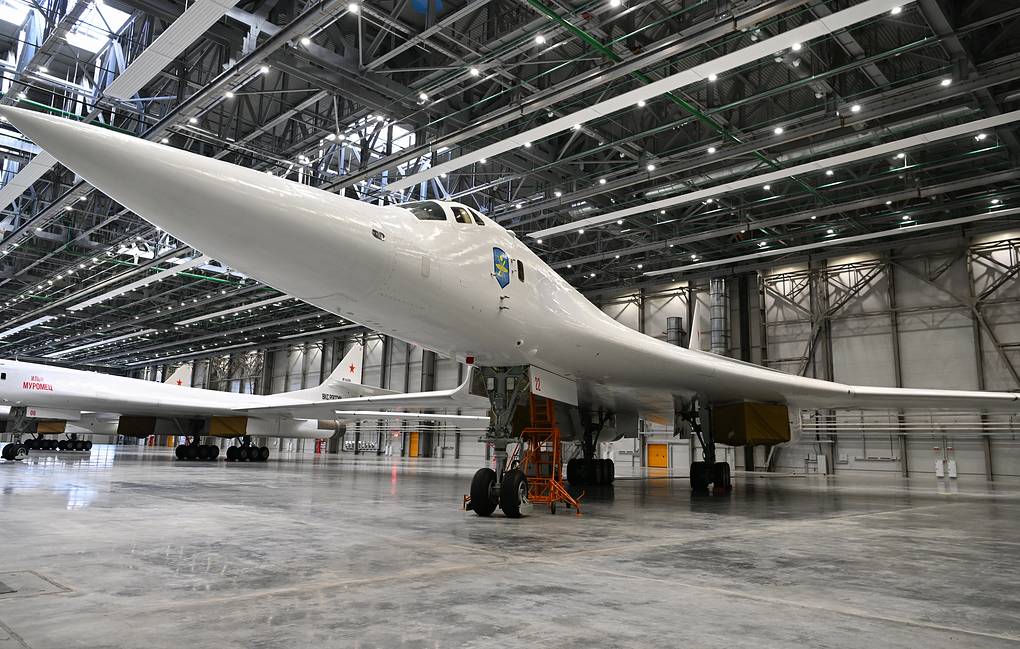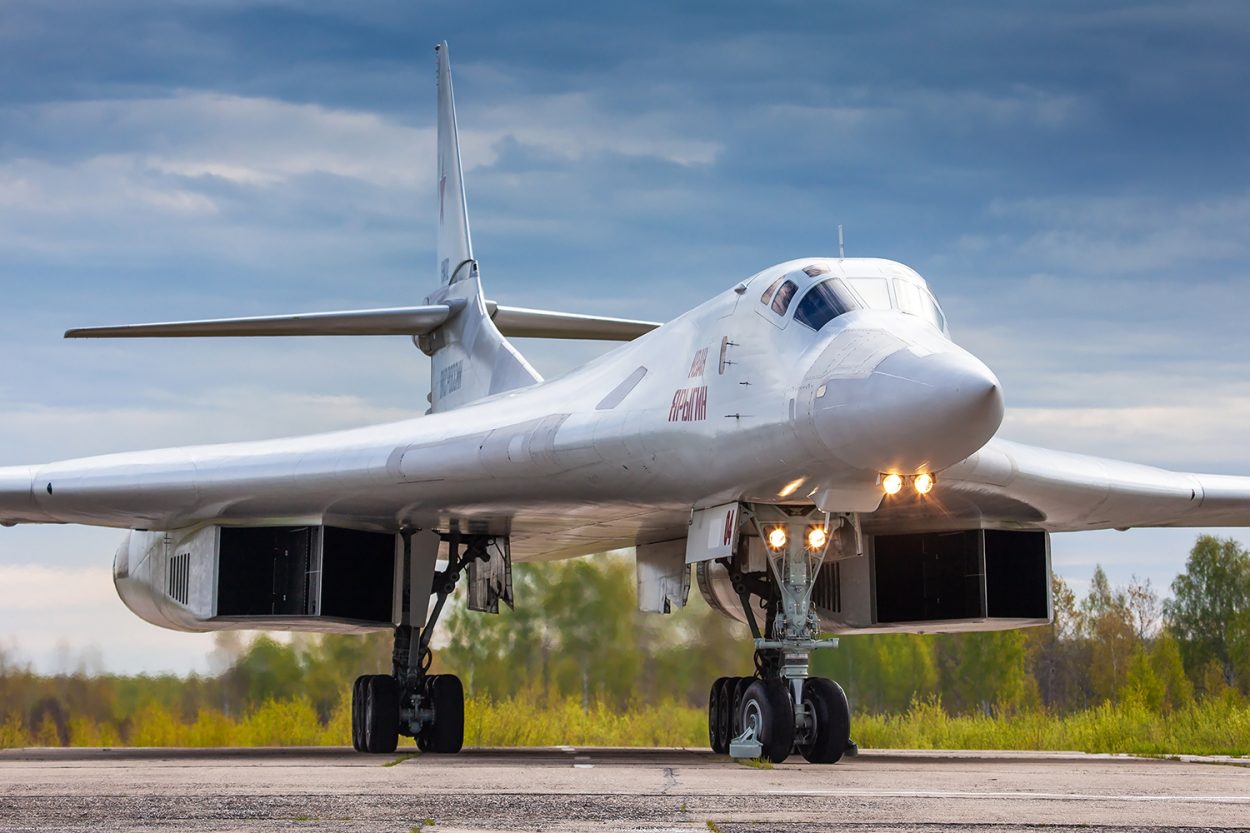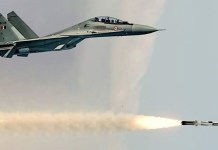Russian President Vladimir Putin took a 30-minute flight on Tu-160M strategic bombers and called the aircraft safe and excellent. Presidential Spokesman Dmitry Peskov told TASS that Putin did not undergo any medical examination prior to flying.
Russian President Vladimir Putin Rides Tu-160M Nuclear Bomber Amid NATO Tensions; Can ‘Knock Out’ Enemy Targets 6,000 KM Away
Story: https://t.co/uyVvZxdrzz pic.twitter.com/GbuUuhorwg
— EurAsian Times (@THEEURASIATIMES) February 22, 2024
Earlier, Putin visited the Kazan Aviation Plant, where he inspected four upgraded Tupolev Tu-160M strategic bombers that can carry and fire missiles at targets 6,000 km away, has underscored Russia’s plans to intervene in any future crisis or conflict with NATO and its allies.
Russia’s SP Gorbunov Kazan Aviation Plant in Tatarstan has readied four Tupolev Tu-160M strategic bombers. The Russian Air Force’s leading aircraft, the Tu-160M, can launch debilitating nuclear and conventional strikes and turn the tide in any war.
Russia claims it is the world’s fastest-flying supersonic and heaviest payload-carrying bomber and, along with the Tu-22M, will remain the mainstay of Russia’s strategic bomber fleet until the PAK-DA is developed and joins service in the 2030s.
It is unknown whether all the Tu-160s are the Tu-160M variants, produced from the ground up, or older models are extensively retrofitted and upgraded to that standard. However, posts on leading Russian Telegram channels indicate that one of the aircraft has to be a pre-existing unit taken in by the factory for upscaling.
Russian defense industry officials have noted improved and optimized production processes, manufacturing techniques, smoother supply chain issues amid Western sanctions on its defense industry and commerce, and enhanced cooperation between the designer, Tupolev Design Bureau (TDB) under the United Aircraft Corporation (UAC), and the Kazan factory.
‘Improved Production of Aircraft’
TASS quoted the CEO of Rostec Corporation, Sergey Chemezov, the parent holding company of all Russian state-owned arms developers, in the backdrop of President Vladimir Putin visiting the Kazan factory.
He said that resuming the production of the Tu-160 White Swan (NATO reporting name Blackjack) “armed with cruise missiles was a great challenge.”

“The affiliated enterprises have coped with this task well enough,” and currently, the Tu-160M “was one of the most powerful combat aircraft in the world.” “Restarting the production of Tu-160 was quite a task for all of Rostec’s affiliates. Design documentation was fully digitized within the tightest deadlines. The technique of vacuum welding of titanium parts was restored, and the production of airframe units was resumed. Today, we can say confidently that we have succeeded in all respects,” he said.
Tu-160M Variant
The upgraded Tu-160M shares much of its predecessor’s design and appearance but boasts a “completely new technological base and digital solutions.” Putin’s visit to the Kazan factory involved the “inspection of four fundamentally upgraded strategic bombers.” He spent 10 minutes in the cockpit, behind a control wheel.
The Tu-160M and M2 upgrade also introduces the new K-042K-1 navigation system, the ABSU-200-1 autopilot, and the NK-32-02 turbofan engine. Touted as the world’s most powerful combat engine, it develops over 55,000 pounds (24,947 kg) of thrust, according to The Warzone.
It also receives the new Novella NV1.70 radar, a computerized “glass” cockpit, the latest communications, and anti-jamming Electronic Support Measures (ESM). With these upgrades, pre-existing one-of-their-kind capabilities, and an ongoing war that allows Russia’s defense industry and military planners to perfect the technology and refine their tactics, training, and procedures (TTP), the plane lends a terrifying airborne strategic strike capability.
Putin “personally” ordered the program to upgrade the variable ‘swing-wing’ Tu-160, which began with Rostec reviving its metallurgical, aircraft design, engineering, and instrumentation division. Russian military bloggers on Telegram (or ‘milbloggers’ as they are known) had hinted that this process began as early as 2014 during the Donbas War when Ukraine’s Russian-speaking regions of Donetsk and Lugansk declared their independence from Kyiv.
How Will the Tu-160 Be Used
Russia had long anticipated a war with NATO and a larger crisis in which it would have to intervene. Subsequent reports and EurAsian Times analysis examined the Russian Aerospace Forces’s (RuAF) tactical and strategic battlefield visions for the aircraft.
In September last year, the Tu-160 was concluded to have received the new 6,500-km range Kh-BD air-launched cruise missile. It was seen in the publicity material of Korean leader Kim Jong Un visiting Russia’s Knevichi base in the Far East.
TASS later quoted RuAF’s Long-Range Aviation commander, Lieutenant General Sergey Koblyash, when Defense Minister Sergei Shoigu and Kim visited the air base. “(A bomber) carries a Kh-BD missile with a range of over 6,500 kilometers,” Koblyash said.
The secretive missile has been assessed to have low-observable shaping and can clock between just short of supersonic to hypersonic speeds. Like the Kh-101, it can change directions mid-flight to confuse enemy air defenses. However, it is unclear if it can also carry nuclear warheads.
Koblyash had said while showing Kim around the Tu-160: “The Kh-BD missile is housed in two cartridges carrying six missiles each.” This translates to a single Tu-160 carrying a payload of 12 Kh-BDs. Its induction is consistent with the prevalent techno-military doctrine of fielding long-range missiles and aviation platforms that allow Moscow to fight off an adversary from a distance without getting close.
Long-range missiles, especially if fired by fast-flying long-range aircraft, make it possible to hit targets in the most remote areas where a strike has at least a semi-strategic impact. This seriously upsets an adversary’s war plans, injecting a sense of vulnerability and forcing complicated workarounds.
Going by the standard military practice, the Tu-160 will fire a salvo of missiles and not a single shot. Even six missiles heading towards a target and periodically changing directions is enough to overwhelm enemy air defenses and exponentially increase the chances of a hit.

‘Hit US & Japan in Western Pacific’
Unnamed Russian defense officials had also mentioned plans to employ the Tu-160 to hit US and Japanese targets in northeast Asia after a rapid deterioration in Russo-Japanese ties over the last two years. This was after Tokyo’s hardline over the war in Ukraine, reviving the Kuril islands’ dispute with Russia and firming a US-Japan-South Korea alliance against a perceived Russia-North Korea-China camp.
According to unnamed sources quoted by Izvestia, the RuMoD, in July 2023, was considering the deployment of a new regiment of the Tu-160 White Swan in the region. If finalized, the bombers will join the 326th long-range heavy-bomber aviation division in the Amur region in the Far East.
“According to experts, the deployment of strategic missile carriers in the Far East should neutralize the threats posed by the United States and its closest allies in the region,” the report added.
RuMoD officials, at that time, had said the decision depended upon the “volume and structure of the state defense order for the coming years.” This referred to the modernization of the current fleet to the ‘M’ variant, which was still underway then.
Military expert Yuri Lyamin quoted in the Izvestia report, said “missile carriers” will be used in the Far East “to deter the United States and its closest allies in the region.” “Particular attention should be paid to Japan, with which we still have territorial disagreements over the South Kurils,” he explained.
According to reports, Japan has been increasing its military spending and plans to develop strike weapons systems. “Therefore, it is necessary to strengthen our deterrence forces to neutralize the threat from this direction,” Lyamin said.
- The author can be reached at satamp@gmail.com
- Follow EurAsian Times on Google News




